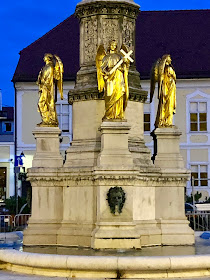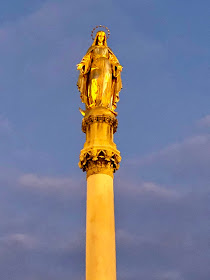Black Lamb and Grey Falcon by Rebecca West
A flight from Boston to Amsterdam to Zagreb. Upon my arrival, on a Friday afternoon, I began my exploration of the Republic of Croatia in Zagreb, its capital. For Friday and part of Saturday, I was on my own, so I checked out places such as Tkalčićeva Street and the Dolac Market. During this short time, I could only check out a tiny portion of the city, but I very much enjoyed what I experienced and would love to return to further explore this fascinating city.
It's easy to walk around Zagreb, enjoying its architecture, restaurants, bars, shops, sculptures, and people. Though modern in many ways, it has its feet firmly in the past, giving a strong old-style ambiance. The people were warm and welcoming, and as most speak English, interactions are easy for tourists, though it wouldn't hurt to learn at least a few words in Croatian, such as hvala, which means "thank you."
The region surrounding Zagreb has been inhabited for thousands of years, including by Illyrians and Celts. The ancient Romans established the settlement of Andautonia, not far from the present site of Zagreb, and it lasted for about 400 years before being destroyed. During the 11th century, in 1094 A.D., the Hungarian King Ladislaus I, who also became the King of Croatia in 1091, established the diocese of Kaptol atop a hill, on the site of the modern-day Zagreb. This diocese soon became wealthy.
A cathedral was eventually constructed atop the hill, not being completed until 1217, though it was destroyed, with much of the rest of the town, by Mongol invaders in 1242. Fortunately, the Mongols soon learned of the death of Ogadai, their Great Khan, so they abandoned Kaptol and the area was quickly rebuilt, including the cathedral. The cathedral (pictured above) is now known as the Cathedral of the Assumption of the Blessed Virgin Mary, and is currently the tallest building in Zagreb.
An earthquake in 1880 cause significant damage to the cathedral but it was restored, and currently, additional restoration is occurring, as you can easily see above. My B&B was located just down the street from this cathedral so I walked by it numerous times. Plus, the spires can be seen from various other parts of the city.
In front of the cathedral is a tall column dedicated to the Virgin Mary, with a few angels at the base.
In 1242, King Bela IV, the King of Hungary and Croatia, approved the creation of a secular town, Gradac, on a hill near Kaptol. Many of its early settlers were foreign merchants and there were soon tensions between Kaptol and Gradac. The two settlements were separated from each other by the Medveščak stream, which was owned by Kaptol. However, Gradac used the water for its mills, causing problems with Kaptol. It's said that most of the battles between these two settlements occurred on a bridge over the stream which joined the two towns, which became known as Kravi Most, the Bloody Bridge. Around the 17th century, after about 200 years of Turkish invasions, Kaptol and Gradac chose to put their disagreements behind them and merge.
The stream was eventually covered over in 1898, but the name Kravi Most has been retained for the street which exists where the bridge was once located. Most tourists that pass by this street probably don't know the bloody origins of this street name.
“Dolac is the prettiest monument to food that Zagreb has. This old market means the same to gourmands as a cathedral means to the believers.”
--Zvonimir Milčec, famed Croatian journalist
Another piece of Zagreb history is the famed Dolac Market, a huge farmer's market that has existed for nearly 90 years, having opened on September 1, 1930. Zagreb had a prior market, called Harmica, but it was thought to be too small for the growing city. After checking out markets in other European cities, plans came together for the creation of the Dolac Market.
The market opens early in the morning and closes in the early afternoon, and is well worth checking out. I stopped here on a Saturday morning, arriving early, when they were still setting up. While they set up, the cafes surrounding the market were open so you could sip a coffee or tea while watching the vendors set up their stalls.
Many women run the various vendor stalls and they are known as kumice, which literally translates as "outdoor market selling women." Shoppers have their favorite kumice, establishing relationships so they can obtain the best produce and other goods. In 2006, a bronze statue, created by Stjepan Gračan and called Kumica Barica, was erected to honor these women. The name "Barica" was chosen by the citizens of Zagreb. The statue is located at the top of the stairway which leads to the open area of fruit and vegetable purveyors.
The market occupies four different areas, both inside and outside, each dedicated to specific products. There is a small, exterior flower market, located at the base of the stairway up to the fruit/vegetable market.
On the street level, there is a large interior market, primarily dedicated to meat, bakeries, and pasta vendors. There are lots of shops in this area and you could easily spend a couple hours wandering the various aisles.
Everything was very clean, and there was plenty of diversity of products, as well as plenty of duplication as well. That raises the question of where do you shop? For example, how do you choose which vendor, out of a couple dozen, to buy your steaks? It's obvious that people likely have their favorite vendors, though it seems you probably won't go wrong with almost any vendor.
The various bakeries provide many different breads and baked goods, and its easy to buy an item or two to eat as you walk around the rest of the market.
This is a Burek, a baked filled pastry, whose origins likely extend back to the Ottoman Empire and which is prepared in various countries, from the Balkans to the Mediterranean. Bureks in Croatia are most commonly filled with meat or cheese, and the pastry is light and flaky. The above is a meat burek and was a tasty breakfast treat. You can find Burek in many pastry shops across Croatia, from Zagreb to Dubrovnik.
At the top of the stairs, you'll find the large, open-air market for the stalls of fruits and vegetable vendors, as well as the cheese vendors and a number of souvenir stalls. Most of the stalls are covered by bright red umbrellas, called the Šestine Umbrella, which derive from the costume of the Šestine people, one of the oldest neighborhoods in Zagreb.
The fruits and veggies certainly looked extremely fresh and prices were relatively inexpensive based on what you might pay at a U.S. farmers market. As I was at the market very early, many vendors were still setting up, and within a couple hours, once everything was set, there were lots of customers wandering the aisles, checking out the produce. A number of restaurants shop at this market, providing fresh produce for their customers later that day.
Along one side of the market are a small number of cheese vendors, each stall offering a variety of different local cheeses. If I had more time, I would have spent it sampling the various compelling cheeses.
Croatians love coffee, and they can sit for hours at a street-side cafe, watching people pass by, chatting with friends, and just enjoying the weather. Surrounding the Dolac Market are several different cafes, where you can have some coffee, or another type of drink, and watch the people at the market. A cup of coffee may run you only $1.00-$1.50 U.S. and most of these spots don't offer any food. They simply provide drinks.
The Dolac Market is a fun and tasty way to spend a morning in Zagreb, plus it's a great place to people watch. And you can then spend the rest of the day exploring other sections of Zagreb, uncovering the other wonders of this Croatian capital.
"Zagreb-March 18: The police were recently called to eject ghosts from a private dwelling. A landlady on Gundulitcheva street complained that mischievous spirits were frightening her tenants.”
--St. Joseph News-Press/Gazette (MO), March 18, 1929
See also:
Strolling Down Tkalčićeva Street (Part 2)
Agava Restaurant--Mediterranean & Croatian Specialties (Part 3)
Art & Shopping--Plus A New Fedora (Part 4)
Agava Restaurant--Mediterranean & Croatian Specialties (Part 3)



































No comments:
Post a Comment